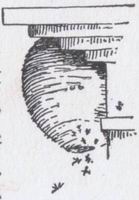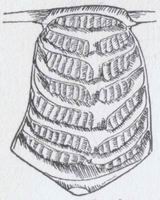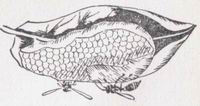|
1999-2004 (Return to Web Text-ures) |
Click Here to return to |
|
1999-2004 (Return to Web Text-ures) |
Click Here to return to |
WASP ARCHITECTURE
 WASPS cling to the traditions of their ancestors
in nest-building. Each species has its own inherited ideas on the subject, and
invariably builds in accordance with those ideas. But while the nests differ in
certain fixed details, in a broad general way they are all alike. All are made
of paper. All contain combs enclosed by separate outer walls. The hornets build
smooth and handsome structures of paper that can be peeled off in large sheets
and they generally have but one entrance hole near the bottom. Some of the
yellow-jackets make nests of coarse, friable materials, that break at the
slightest touch. Sometimes sand is found in the paper of which wasps' nests are
built, and some yellow-jackets lay on their walls, not in large separate sheets,
but in the form of shell-work, or overlapping scales: Such nests generally have
several entrance holes and are often very handsome structures.
WASPS cling to the traditions of their ancestors
in nest-building. Each species has its own inherited ideas on the subject, and
invariably builds in accordance with those ideas. But while the nests differ in
certain fixed details, in a broad general way they are all alike. All are made
of paper. All contain combs enclosed by separate outer walls. The hornets build
smooth and handsome structures of paper that can be peeled off in large sheets
and they generally have but one entrance hole near the bottom. Some of the
yellow-jackets make nests of coarse, friable materials, that break at the
slightest touch. Sometimes sand is found in the paper of which wasps' nests are
built, and some yellow-jackets lay on their walls, not in large separate sheets,
but in the form of shell-work, or overlapping scales: Such nests generally have
several entrance holes and are often very handsome structures.
As a rule the nests built by yellow-jackets in the ground have coverings of coarser material and less elegant architecture than nests built in trees or under roofs. But even where the nest is in the ground, it has its covering of paper walls. Certain species of yellow-jackets, or ground-wasps, as they are often called, take possession of a hole they find, and this they enlarge to suit their needs by biting off and carrying out, bit by bit, the earth. They are cave-dwellers, but their caves are made warm and comfortable by the paper lining they always give them. It is quite a surprise to dig out one of these nests for the first time and find the snug and complete habitation, often of quite large size, and fitted up with its tiers of combs and all the essential parts of an out-door nest.
All wasps' nests are able to resist moisture to quite an astonishing degree, because of the glue-like saliva with which the building materials are welded together and with which the nest is sometimes varnished over.
The strength of paper depends largely upon the length of the fibres of which it is made, and Vespa, using very friable materials, makes them as serviceable as possible by gnawing the wood lengthwise of the grain, instead of cutting it up into sawdust. Thus she is able to convert wood into a paper that holds together as long as she needs it.
In late years the wasp's secret of making paper from wood-pulp has been discovered by man, and truth to tell, the product he supplies is sometimes little better than wasp paper in strength or appearance. Some consider the wasp paper far the prettier.
Since Vespa builds her habitation of paper which she herself manufactures, and since she is a creature of resources, she is willing to use any good paper-making material that comes her way.
She, no doubt, prefers the wood fibre or the fibre obtained from leaves or roots used by her ancestors for countless generations, yet if that is not convenient she does not hesitate to take any reasonable substitute. She has been known to make a gay abode of bright colours from unknown materials. The author of “Homes without Hands,” says,
“I have seen a nest which was made almost entirely of the blue and white paper used for cartridges, the wasps having taken advantage of the expended papers, and used them instead of taking the trouble to gnaw hard wood.”
Vespa does not use ready-made paper, but chews it up and re-spreads it, so to speak, into wasp paper.
The present writer once took a yellow-jacket's nest in which the predominating colours were dull red and yellow, and the outer wall was laid on in a fine and very elegant shell pattern. The paper of this nest was so very brittle that it fell to pieces at the slightest touch, and the nest itself was built to fit in an irregular space in a cornice at the corner of a piazza. There were half a dozen or more entrance holes scattered over the walls of the nest, a common thing in this form of architecture.
Generally wasp paper is grey in colour, for generally it is made of weather-worn wood. Usually the grey is in bands of alternating light and dark, and often these bands are in waving lines, which gives a pretty effect to the whole.
Favourite building-sites for hornets and the tree-dwelling yellow-jackets, are wooded mountain sides. The wasps enjoy the seclusion of the woods, and are apt to be a little inhospitable -- some might go so far as to say resentful -- when the children of men wish also to enjoy the mountain slopes, as most climbers have had reason to know. The hornets, no doubt, cannot comprehend a mental condition which sends creatures wandering about strange forests for the mere pleasure of wandering, and when they see the terrifying biped approach and intrude upon what they consider their territory, wild with fear and rage they sally forth, and without word of warning smite the happy and unsuspecting pilgrim into a temporary indifference to the beauties of nature.
They like also to build in swampy places, but they are not very conservative on the subject of building-sites, and often choose to hang their nests in a snug corner under the rafters of a barn or the eaves of a building.
In hot countries the social wasps are more abundant than in temperate climates, and all sorts of queer-looking nests may be met with in the forests and jungles of the tropics. There are a good many species scattered over the world that are not represented in North America at all. Some build enormous nests with a hard, crust-like covering ornamented with many projections which cause them to look like monstrous fruits with rough rinds. But woe to the ignorant traveller who seeks to possess himself of this strange tropical fruit!
A South American species builds a bag-like nest several feet long and crowded with tens of thousands of cells, the whole encased in a hard rind-like covering.
Wasps seem to make their nests according to the circumstances of their lives. In India, where the dry season lasts the lifetime of the wasps, one large species of Vespa builds its nest of mud. When the rains come the queens hide away, ready to start a new nest at the beginning of the next dry season.
 In Demerara, where the storms are violent, the
nests are often covered with a hard case, one species making a beautiful white,
polished cardboard-nest, so strong and compact that it can withstand the hardest
rainstorm. This nest is usually broadest at the top, and is entered by a hole in
the bottom.
In Demerara, where the storms are violent, the
nests are often covered with a hard case, one species making a beautiful white,
polished cardboard-nest, so strong and compact that it can withstand the hardest
rainstorm. This nest is usually broadest at the top, and is entered by a hole in
the bottom.
The combs are very regular in form, and very prettily placed within their protecting walls.
It is said the mocking-birds build their nests above those of the card-board wasps to secure their young from the attacks of monkeys.
Monkeys are fond of young birds, but seldom would one be hardy enough to try for a meal by climbing over a wasp's nest!
The mocking birds are not the only ones wise enough to make the wasps their garrison of defence, for there is a little fly-catcher in South America that makes its home close to the nest of one of the social wasps.
There is a South American wasp that builds its combs in concentric spheres, instead of in horizontal layers, and this thickly packed interior is surrounded and protected by a very thin wall.
Another social wasp builds its comb along the trunk of a tree, covering it over with an outer shell.
A pretty little nest is found in South America attached to the under side of a large, strong leaf. It consists of one flat comb of tiny cells covered over by a hard shell or wall.
 Indeed there seems to be no end to the variety
in form, size and material of the nests of the social wasps in different parts
of the world, and the traveller in tropical countries will do well to remember
never to interfere with a queer-looking object hanging on a tree -- or anywhere
else for that matter.
Indeed there seems to be no end to the variety
in form, size and material of the nests of the social wasps in different parts
of the world, and the traveller in tropical countries will do well to remember
never to interfere with a queer-looking object hanging on a tree -- or anywhere
else for that matter.
It is wiser to let it alone and find out what it is by asking.